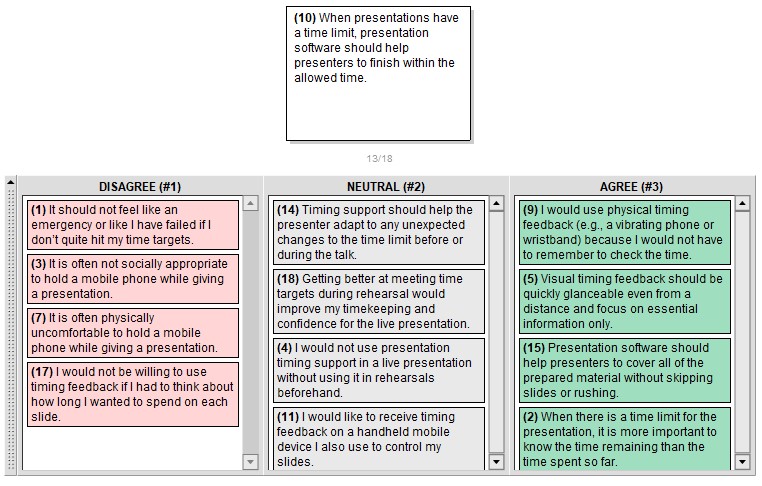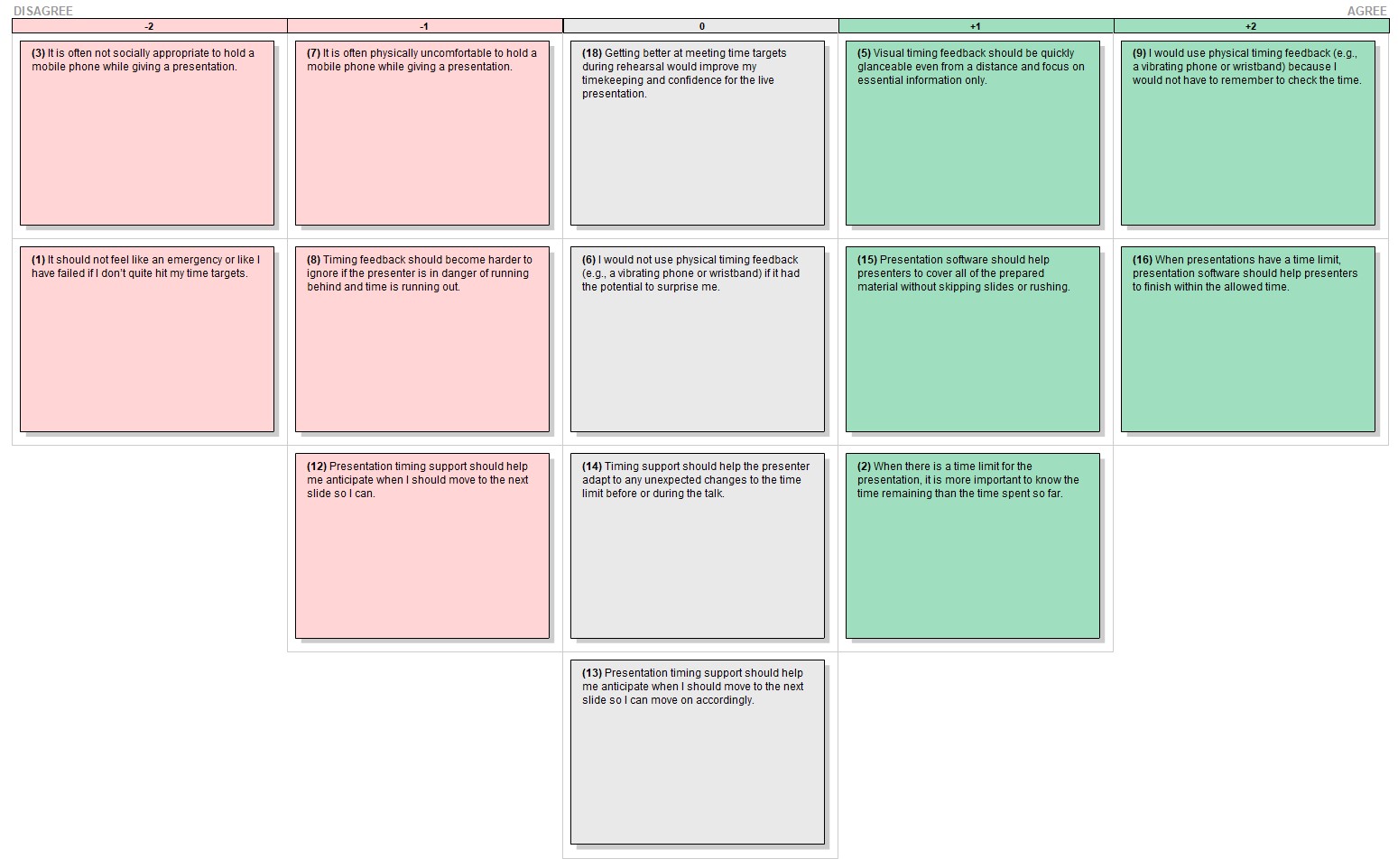TalkZones: Section-based Time Support for Presentations
About
Oral presentations often have predefined time limits that speakers should not exceed out of respect for the audience’s time and the following schedule of events. However, the cognitive challenges of dividing attention with the secondary pacing task and the social pressure of maintaining a level of engagement with the audience mean that presenters may not be able to fully attend to their timing while they are speaking. Previous approaches to presentation timing support have also failed to control talk pacing and time overruns adequately.
During my internship at Microsoft, I worked with a cross-functional team to explore how a mobile application could support all stages of the presentation time management process, from planning and refinement to rehearsals and delivery. This project won honorable mention award at MobileHCI conference and was presented as a fully-functional demo in Techfest, Microsoft's yearly event that covers internal cutting-edge research projects.
My Role
As an intern, my main responsibilities included:
- 01. Conducting user research with experienced presenters to identify their attitudes towards timing support
- 02. Designing low and high-fidelity alternative solutions
- 03. Implementing a solution using the C# programming language
- 04. planning and condcuting two different between-subjects control experiments to measure the effectiveness of our proposed solution
Duration
5 months
Team Size
5 People
...
UX Process
Keeping the end-users at the center of our design process, we worked closely with a cross-functional team to design an innovative solution that was tailored to the user’s needs.

...
User Research
Understanding Attitudes to Timing Support through Q-Methodology
We used Q-methodology to understand potential users' attitudes towards presentation timing support. We recruited 20 participants with experience giving timed talks at formal events.
In the first stage, participants read each statement, asked the experimenter for further explanations if necessary, then provisionally assigned the statement to one of three groups: agree, neutral, and disagree. This familiarized the participant with all statements and began the process of differentiation. Participants were allowed to explain their reasonings when assigning the satatements to a particular group.
Main Findings of Our Initial User Research
- 01. Majority of our participants agreed that sound-based feedback is likely to be distracting.
- 02. Our participants strongly disagreed that presentation software should help presenters cover all of the prepared materials without skipping slides or rushing.
- 03. The potential for using mobile devices is high, with participants wanting to set time targets in advance and less-flexible presenters preferring to passively glance at a mobile device, while more-flexible presenters want to use their mobile device in hand.
- 04. Several of our participants suggested the ability to set time targets for variable-length sequences of slides, starting with a time limit for the whole talk and refining into section targets and then slide targets only when necessary.
...
Design
High-fidelity Prototype
Below, I describe how we translated our design goals into concrete features of a mobile application called TalkZones. This Windows Phone application communicates with a Microsoft PowerPoint Add-In over Bluetooth, synchronizing time data in the XML of the .pptx file format allowing the same presentation to be paired with any mobile device. TalkZones also provides the high-level capabilities of time planning, time feedback, and remote control of the PowerPoint slideshow.
Please read our paper [here] for more information about design decisions made while designing and developing our solution.
...
Evaluation
Our evaluation of TalkZones spans two related studies. The goals of the first study were to understand how participants choose to configure and use TalkZones under various scenarios, and to compare the performance of TalkZones to that of a regular timer for controlling the pace of a short talk. The second study built on the first by testing how well TalkZones could pace longer talks with speakers’ own slides.
Study 1: Presenting Short but Interrupted Talks
We employed a between-subject design because familiarization with materials and timing strategies in one condition could impact performance in the other condition. We recruited 24 participants with experience in giving timed presentations were recruited, half of whom used TalkZones after training and preference elicitation, while the other half used a minimal TalkZones application as a regular countdown timer. User preferences were collected using a deck of 20 slides with prompts, such as "My home town" and "My university life". We then provided the following instructions for participants:
- 01. Speak continuously and maintain good eye contact (as recommended in the presentation literature).
- 02. Miss early targets by longer times, but gradually catch up (to experience the feeling of recovering from being late).
- 03. Gradually move back to the longest glanceable distance (to discover the potential of mobile timing display).
We preconfigured a talk time limit of 6 minutes 40 seconds. This corresponds to the total time available in the Pecha Kucha talk format of presenting 20 slides, each of which automatically advances after 20 seconds. This format was invented to tackle the problem of presenters overrunning in talks whose allocated time was already longer than needed to communicate the core message. The use of auto-forward is “all important” because “There’s no ‘next slide’ or ‘go back one, please’ at PechaKucha Nights”. Presenting so many slides in such a short time without the use of auto-forward creates a high level of time pressure from the outset, making it an ideal format to test our visualizations. Following these sensitizing experiences, we invited participants to experiment with the option of late coloring (red for late, blue for not late, regardless of the section) as well as the use of handheld control and haptic feedback.
Our findings showed that completion times in the TalkZones condition ranged from a 25s underrun to a 35s overrun, with a mean overrun of 8s (SD: 18s), or 2% over the target completion time. In contrast, participants using a regular timer in the control condition all ran over by 25-220s, with a mean of 1m49s (SD: 1m11s), or 27% over the time limit. A Welch’s t-test revealed a significant difference (t(12.7)=4.87, p<.0001, Cohen’s d=1.97), translating to a 14× improvement with TalkZones. Overall, participants reported that “it is easy to divide each section [zone]” and that the “smaller goals” of zone targets helped them to “quickly notice the remaining time” when considering slide transitions. When overrunning in a zone, the adaptively “shrinking space” of future zones helped participants to “pre-manage” their timing before it was too late, resulting in a “sense of security” and feeling of control.
Study 2: Presenting Longer but Shortened Talks
The second study evaluated whether TalkZones' effectiveness for pace control in short talks could also transfer to longer talks under time pressure. Eight participants with backgrounds in science and engineering, who had not participated in earlier studies, were recruited. They were instructed to prepare a 30-minute presentation and then asked to give the presentation in just 20 minutes to simulate time pressure situations commonly faced in real-world scenarios.
In their timed talks, the mean and maximum overruns corresponded to 2% (23s) and 10% (2m3s) of the 20 minute time limit, again highly consistent with the 2% and 9% mean and maximum overruns from the first user study. From these results, we can conclude that TalkZones is an effective means of timing support for short-to-medium length presentations. Taken together, our results suggest that mobile phones are a suitable platform for presentation timing support, and that our TalkZones application gently encourages presenters to advance slides before it is too late to recover, even under the adverse timing conditions of short and shortened talks.
...
Key Takeaways
- 01. A deeper understanding of the importance of user research in the design process.
- 02. A sense of accomplishment in helping to create user-centered products or services that meet the needs of the target audience.
- 03. Enhanced communication and collaboration skills through working with cross-functional teams.
- 04. A better understanding of the business objectives and how they relate to the user experience.
- 05. The importance of communication and collaboration skills in working with individuals from different functional areas of the organization.

